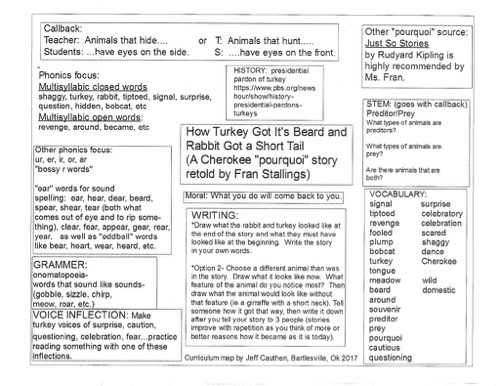How the Turkey got its Beard and Rabbit got a Short Tail
Teaching Science, Technology, Engineering and Mathematics
Fran Stallings, a storyteller based in Oklahoma, works on a weekly basis with a local 2nd grade class (7- to 8-year-old children). Their classteacher, Mr C, uses the story she tells as the basis for an amazing amount of his teaching, in particular in the STEM subjects.
Fran has posted some details of this work on the Storytell listserv. She has generously given permission for me to publish some of them here – until such time as she creates pages on her own website.
Below are some of them.

This is a tale I heard many years ago from a Muskogee/Creek teller. I haven’t found a print source; maybe you’ll recognize it from this synopsis:
Back in the days when rabbits had long bushy tails, Bobcat caught a rabbit who objected, “You don ‘t want to eat me, I’m too skinny! Wouldn ‘t you rather eat a nice plump turkey?” Bobcat said that would be nice but the wild turkeys were too difficult to catch. Rabbit persuaded Bobcat to try luring the turkeys close enough to catch by pretending to be dead: lie on your back with your feet in the air, close your eyes and stick out your tongue, keep very still. (Young students love to try this. Gross! a room full of dead bobcats!)
Rabbit then found the turkeys and claimed to have killed Bobcat in a fight. Turkeys were doubtful, but went to see for themselves, cautiously getting closer. Indeed Bobcat appeared to be dead. Happy turkeys did a celebration dance – until Bobcat leapt up and grabbed a couple! Turkeys ran off squawking.
But wild turkeys are not stupid. They realized Rabbit had lied to them, and decided to get revenge. They found Rabbit nibbling clover in the meadow, his long bushy tail spread out behind him. They pounced – but Rabbit’s eyes* spotted them, and Rabbit fled almost in time: turkeys landed on his tail. He tugged and tugged to get loose. Snap! off came the tail, and Rabbit got away. But the turkeys did a victory dance with the tail, and then shared pieces to wear around their necks to show what powerful warriors they are.
Male wild turkeys still have a beard and rabbits still have short tails.
Before I started the story, we talked about wild rabbits, bobcats, and turkeys. Here in NE Oklahoma, many of the students have seen these animals and several had eaten wild turkey hunted by their relatives! But only a few knew about the “beard,” so I showed a printout of the jpg cited above.
During the story, I repeated the “pretend dead bobcat” description several times because the kids really like imitating that, and the humor helps diffuse angst about dead animals. However these kids seem to know quite well that “meat” is Animal Parts.
We illustrate the turkeys’ changing moods by making turkey noises that are: doubtful, cautious, surprised, pleased, and finally very happy (Bobcat is dead!). Here’s a fairly contented turkey.
After the story, we reviewed the outline as usual, then talked about the way this story pretends to “explain” rabbits’ short tails and the turkeys’ beards. We already had two Anansi stories that “explained” why spiders are bald and have narrow waists.
This genre is called Just So (thanks to Kipling) or Pourquoi (French for “why”), and of course the traditional tellers and listeners knew it was fiction. They told these stories for fun – and also to teach about human behavior. People who lie or play mean tricks on others, will suffer unexpected consequences. The tails, beards, heads, waists will remind us of that every time we see them.
I showed the students a simple way to fold a sheet of paper into a booklet. Back cover shows the animal’s appearance now. Front cover shows how you imagine it looked before. Inside, draw what happened to cause the change. Mr C will have them use this format to illustrate their practice retellings of this story. It can also be used with an original Pourquoi story, but they won’t write it down until they have told it to three different classmates (improves each time!)
Mr C has already produced a Curriculum Map showing the many language and STEM applications he thought of!
We plan to post full story texts, student work, and Mr C’s Maps on a new page on my website.
* Their new “call-back” was taught to me by a park ranger:
T: Animals that hide S: have eyes on the side.
T: Animals that hunt S: have eyes on the front.

Below are some more of Fran’s posts
They are in no particular order, but serve to show what is possible.
Visit Fran’s website
to find more about her wide range of work.
In particular, explore the Earth Teller Tales, where she shares many articles about teaching natural science through storytelling.
Fran’s article The Web of Silence: Storytelling’s Power to Hypnotize is a deep exploration of many aspects of the storytelling experience, including the storytelling trance. It also offers great insight into the whole art itself.
Fran can be contacted here.
Further resources relating to storytelling in schools
- Science teaching: Hawthorn Press
- Generally using storytelling in schools: Storytelling schools
Go here for a list of all tales included on this site
Go here to receive an e-mail notification when new tales are added
Permission to tell outlines my views on copyright
For those who are teachers: Telling stories in the classroom: basing language teaching on storytelling
